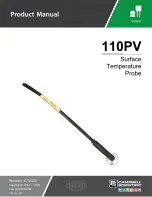
HeatLink
®
Mixing Valve Reset Control Stk# 31360
H
e
a
tL
in
k
®
Link
Heat
13
www.heatlinkgroup.com
Installation
Important: Improper installation and operation of this control could result in damage to the equipment and possibly
even personal injury. It is your responsibility to ensure that this control is safely installed according
to all applicable codes and standards. This electronic control is not intended for use as a primary limit
control. Other controls that are intended and certified as safety limits must be placed into the control
circuit.
Step One - Materials
Check the contents of this package. If any of the contents listed are missing or damaged, please contact your wholesaler or HeatLink
®
sales
representative for assistance.
Type Stk# 31360 includes: One Mixing Valve Reset Control Stk# 31360, One HeatLink
®
Outdoor Sensor Stk# 30070, Two HeatLink
®
Universal
Sensors Stk# 30071; Literature: L631360, L630070, L631000, TN13.
Note:
Carefully read the details of the Sequence of Operation to ensure that you have chosen the
proper control for your application.
Step Two - Mounting the Base
Remove the control from its base by pressing down on the release clip in the wiring chamber and sliding the control away from it. The base is then
mounted in accordance with the instructions in the 10K Sensors L630070.
Step Three - Rough-in Wiring
All electrical wiring terminates in the control base wiring chamber. The base has standard 7/8" (22 mm) knockouts which accept common wiring
hardware and conduit fittings. Before removing the knockouts, check the wiring diagram and select those sections of the chamber with common
voltages. Do not allow the wiring to cross between sections, as the wires will interfere with safety dividers which should be installed at a later
time.
Important: Power must not be applied to any of the wires during the rough-in wiring stage.
• Install the HeatLink
®
Outdoor Sensor Stk# 30070, HeatLink
®
Boiler (Universal) Sensor Stk# 30071, and HeatLink
®
Mixing (Universal) Sensor
Stk# 30071 according to the instructions in the 10K Sensors L630070, and run the wiring back to the control.
• If an HeatLink
®
Indoor Sensor Stk# 30076 or Stk# 30077 is used, install the indoor sensor according to the instructions in the 10K Sensors
L630070 , and run the wiring back to the control.
• Run wire from other system components (pump, boiler, actuating motor, etc.) to the control.
• Run wires from the 120 V (ac) power (North American version) or 230 V (ac) power (European version) to the control. Use a clean power
source to ensure proper operation. Multi-strand 16 AWG wire is recommended for all 120 V (ac) or 230 V (ac) wiring due to its superior
flexibility and ease of installation into the terminals.
Installation
Step Four - Electrical Connections to the Control
The installer should test to confirm that no voltage is present at any of the wires. Push the control into the base and slide it down until it snaps
firmly into place.
Powered Input Connections
120 V (ac) Power (North American version)
Connect the 120 V (ac) power supply to the Power L and Power N terminals (3 and 4). This connection
provides power to the microprocessor and display of the control. As well, this connection provides power
to the Sys Pmp terminal (5) from the Power L terminal (3).
230 V (ac) Power (European version)
Connect the 230 V (ac) power supply to the Power L and Power N terminals (3 and 4).This connection
provides power to the microprocessor and display of the control. As well, this connection provides power
to the Sys Pmp terminal (5) from the Power L terminal (3).
Mixing Demand (North American version)
To generate a mixing demand, a voltage between 24 V (ac) and 240 V (ac) must be applied across the
Mixing Demand terminals (1 and 2).
Mixing Demand (European version)
To generate a mixing demand, a voltage of 24 V (ac)or 24 V (dc) must be applied across the Mixing
Demand terminals (1 and 2).
3
4
120 V (ac) North America
230 V (ac) Europe
L
N
Power
1
2
Mixing
Demand
24 to 240 V (ac) North America
24 V (ac) or 24 V (dc) Europe
North American & European Versions
(differences where noted)
Summary of Contents for 31360
Page 29: ...This page is intentionally blank...
Page 33: ...This page is intentionally blank...














































